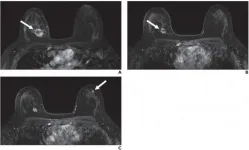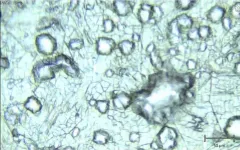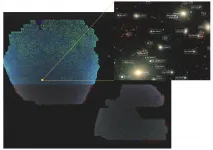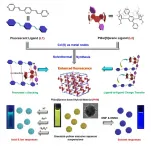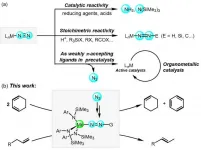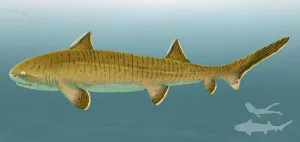New algorithm mimics electrosensing in fish
2021-01-14
(Press-News.org) While humans may struggle to navigate a murky, turbid underwater environment, weakly electric fish can do so with ease. These aquatic animals are specially adapted to traverse obscured waters without relying on vision; instead, they sense their environment via electric fields. Now, researchers are attempting to adapt these electrosensing techniques to improve underwater robotics.
Scientists have spent years studying how weakly electric fish--including the knife fish and elephantnose fish--utilize electricity for navigation. These fish have specialized electric organs that discharge small voltages into the surrounding water, creating their own personal electric fields. Nearby objects cause slight disruptions to these fields, which the fish detect with sensitive organs on their skin called electroreceptors. As a fish swims around, it can sense an object from multiple viewpoints to learn more about its features -- all without gaining any visual perspective. Fully understanding the mechanisms of this unique adaptation that allows fish to orient themselves and navigate in complete darkness could help underwater robots do the same.
Lorenzo Baldassari and Andrea Scapin of the Swiss Federal Institute of Technology in Zürich were intrigued by the possibility of modeling the way in which weakly electric fish perceive their environments through electricity. In a paper publishing on Thursday in the SIAM Journal on Imaging Sciences, Baldassari and Scapin introduce an innovative algorithm for observing objects via electrosensing that is based on the real behavior of weakly electric fish. "These animals are an ideal subject for developing new bio-inspired imaging techniques," Baldassari said.
Weakly electric fish's impressive sensing capabilities inspired the duo to develop an algorithm that could emulate how the fish detect and locate a target based on the distribution of electrical current over their skin. They sought to create a mathematical simulation of a fish that would swim in circular paths around a target object and incorporate a recognition algorithm that could synthesize the electrosensed information to determine what object the fish was near.
The algorithm needed to know the possible shapes of this object, so Baldassari and Scapin established a dictionary of seven standard shapes: a circle, ellipse, triangle, bent ellipse, curved triangle, gingerbread man, and drop. In their simulation, a fish swam around a randomly-selected object from the dictionary -- this theoretical fish did not know beforehand what kind of object it would encounter, just like a real fish does not know about its environment before electrosensing it. The algorithm's goal was then to use the data collected by the simulated fish to determine which dictionary element matched the target object.
The most important mathematical quantity in this simulation was the length-scale, or the ratio between the target's size and the distance between the fish and the target. As the length-scale increases--i.e., the fish moves closer to the target--the size of the electrical disturbance from the target also increases, providing a higher-resolution view of the object. Previous studies involving electrosensing algorithms only utilized measurements taken at one length-scale. To improve upon this technique, Baldassari and Scapin had their modeled fish take multiple circular orbits at different distances from the target, thereby obtaining measurements at several different length-scales. This multi-scale approach combines information that the theoretical fish gathers at different distances from the object to gain a more accurate understanding of its features. But the advantages of multi-scale did not come easily. "The most difficult aspect of this work was choosing a proper way for combining the information at multiple length-scales," Scapin said. The authors attempted multiple methods before finally landing on a strategy for combining the information that did not have any major drawbacks.
For the recognition algorithm that worked best, the first step was to measure and record the electric perturbation from the target that the fish detected upon each orbit. A matching procedure then compared this data to the dictionary of possible shapes, giving a numerical score to indicate the degree of similarity between the unknown target and the dictionary item that it most resembled. This score was saved for later combination. "The strong point of our recognition algorithm is that when performing the classifications orbit-by-orbit, previous comparisons are incorporated in the selection of the best matching shape," Scapin said. "This leads to an enhancement in the recognition." The team combined the numerical scores from different orbits to create a belief assignment that denoted which dictionary shape the algorithm determined was the best match for the target, and how confident it was in that determination.
To test their recognition algorithm, the authors simulated a fish with 1,024 electroreceptors evenly distributed on its body that made three circular orbits around an object, then recorded how often it was able to correctly identify the target. This new multi-scale approach had a higher rate of correct recognition than previous single-scale approaches; although fusing the results from different length-scales did not produce the best outcome every single time, it was the most effective approach overall. According to these results, future advancements in electrosensing algorithms will be most successful if they continue to incorporate multi-scale measurements.
Baldassari and Scapin's new electrosensing algorithm has the potential to advance navigation in underwater robotics, though applying their procedure to real devices would require extending the algorithm to handle three dimensions. However, the potential rewards for such an effort are tantalizing. "Building autonomous robots with electrosensing technology may supply unexplored navigation, imaging, and classification capabilities, especially when sight is unreliable due to the turbidity of the surrounding waters or poor lighting conditions," Baldassari said. Electrosensing robots could enable a deeper study of areas of the ocean that are inaccessible to human divers, advancing undersea exploration further than ever before.
INFORMATION:
Source article: Baldassari, L., & Scapin, A. (2021). Multi-scale classification for electrosensing. SIAM J. Imag. Sci. To be published.
[Attachments] See images for this press release:
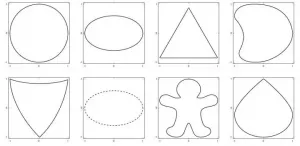
ELSE PRESS RELEASES FROM THIS DATE:
2021-01-14
There is a growing consensus among scientists as well as national and local governments representing hundreds of millions of people, that humanity faces a climate crisis that demands a crisis response. New research from the University of California San Diego explores one possible mode of response: a massively funded program to deploy direct air capture (DAC) systems that remove CO2 directly from the ambient air and sequester it safely underground.
The findings reveal such a program could reverse the rise in global temperature well before 2100, but only with immediate and sustained investments from governments and firms to scale up the new technology.
Despite the enormous undertaking explored in the study, the research also reveals the need ...
2021-01-14
Leesburg, VA, January 14, 2021--According to ARRS' American Journal of Roentgenology (AJR), new suspicious findings occurred in 5.5% of breast MRI examinations performed to monitor response to neoadjuvant therapy; none of these new lesions were malignant.
"Our findings suggest that new lesions that arise in the setting of neoadjuvant therapy are highly unlikely to represent a new site of malignancy, particularly if the index malignancy shows treatment response," wrote Donna A. Eckstein and colleagues in the department of radiology and biomedical imaging at the University of California, San Francisco.
Based on a presentation at the ARRS 2019 Annual Meeting, Honolulu, ...
2021-01-14
Scientists at the University of Tsukuba show that using a layer of graphene just one atom thick improves the catalytic activity of nickel or copper when generating hydrogen gas, which may lead to cheaper fuel for zero-emission automobiles
Tsukuba, Japan - A team of researchers led by the Institute of Applied Physics at the University of Tsukuba has demonstrated a method for producing acid-resistant catalysts by covering them with layers of graphene. They show that using few layers allows for greater proton penetration during a hydrogen evolution reaction, which is crucial for maximizing ...
2021-01-14
The Beijing-Arizona Sky Survey (BASS) team of National Astronomical Observatories of Chinese Academy of Sciences (NAOC) and their collaborators of the Dark Energy Spectroscopic Instrument (DESI) project released a giant 2D map of the universe, which paves the way for the upcoming new-generation dark energy spectroscopic survey.
Modern astronomical observations reveal that the universe is expanding and appears to be accelerating. The power driving the expansion of the universe is called dark energy by astronomers. The dark energy is still a mystery and accounts for about 68% of the substance ...
2021-01-14
Organic luminescent materials have been highlighted as an exciting research topic owing to their prominent potentials in light-emitting diodes, fluorescent sensors, optoelectronic devices, in vivo imaging, anti-counterfeiting, data storage, and information encryption. However, applications of tunable fluorescent materials in the solid states have been largely hampered because these luminescent systems generally require time-consuming organic synthesis procedures and suffer from reduced photoluminescence (PL) owing to the notorious aggregation caused quenching. Aggregation-induced ...
2021-01-14
As an elementary type of collective excitation, plasmon has been found to dominate the optical properties of metals. The collective behavior of electrons in plasmons reflects the important difference between condensed matter and molecule-like ones. It is of great significance to study the evolution of plasmonic response and find out the boundary.
Controversy exists on such interesting questions as the division between the nanoparticle and molecules, and the physics of mesoscopic and microscopic plasmonic evolution. A unified understanding covering the small and large size limit, namely macro / meso / micro scales with sufficiently atomic precision is thus required. Clusters, as the transition from atomic molecules to condensed matter, are the ideal candidate for studying the evolution ...
2021-01-14
Making people stand in front of a scanner to have their body temperature read can result in a large number of false negatives, allowing people with Covid-19 to pass through airports and hospitals undetected.
A new study argues that taking temperature readings of a person's fingertip and eye would give a significantly better and more reliable reading and help identify those with fever.
The study, co-led by human physiologist and an expert in temperature regulation, Professor Mike Tipton, is published in Experimental Physiology.
Professor Tipton, ...
2021-01-14
Dinitrogen (N2) fixation is considered as one of the most essential tasks in basic science, providing straightforward methods to produce ammonia and nitrogen-containing molecules. Exploring the reactivity of N2 units of transition metal-nitrogen complexes is of great significance and challenging in the chemistry. Since the first Ru-N2 complex was prepared in 1965, important progress has been made in the synthesis and reactivity of transition metal nitrogen complexes. In many cases, terminal end-on M-N2 complexes as the most prevalent bonding mode were proved ...
2021-01-14
In a new study, an international research team led by Sebastian Stumpf from the University of Vienna describes an exceptionally well-preserved skeleton of the ancient shark Asteracanthus. This extremely rare fossil find comes from the famous Solnhofen limestones in Bavaria, which was formed in a tropical-subtropical lagoon landscape during the Late Jurassic, about 150 million years ago. The almost complete skeleton shows that Asteracanthus was two-and-a-half meters long in life, which makes this ancient shark one of the largest of its time. The study is published in the journal Papers in Palaeontology.
Cartilaginous fishes, which include sharks and rays, are one of the most successful vertebrate groups still ...
2021-01-14
Climate and changes in it have direct impacts on species of plant and animals - but climate may also shape more complex biological systems like food webs. Now a research group from the University of Helsinki has investigated how micro-climate shapes each level of the ecosystem, from species' abundances in predator communities to parasitism rates in key herbivores, and ultimately to damage suffered by plants. The results reveal how climate change may drastically reshape northern ecosystems.
Understanding the impact of climatic conditions on species interactions is imperative, as these interactions include such potent ecological forces as herbivory, pollination and parasitism.
Lead researcher Tuomas Kankaanpaa from the Faculty of Agriculture and Forestry, University of Helsinki, investigated ...
LAST 30 PRESS RELEASES:
[Press-News.org] New algorithm mimics electrosensing in fish


